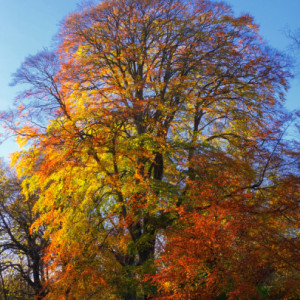The colours of autumn
This slimy character is the Porcelain Fungus Oudemansiella mucida. When fully grown it is pure white and semi-translucent, befitting its common name.
Porcelain fungus is specific to beech wood. It appears in late summer until late autumn on dead trunks and fallen branches and sometimes on dead branches high up in living trees. It is also named the poached egg fungus or slimy beech cap.
Porcelain fungus can completely take over a dead tree, and fights off rival fungi with its own powerful fungicide. Studies of this in the 1980s led to the creation of a safe and effective group of agricultural fungicides called the strobilurins which have massively improved yields of wheat and fruit crops.
The genus Oudemansiella is named after Cornelis Antoon Jan Abraham Oudemans (1825-1906), Dutch physician, botanist and mycologist. The specific epithet mucida refers to the thick mucus that covers the upper surface of a porcelain fungus cap.
The "extra" shows the other extreme of Mother Nature's paint box; autumn wouldn't be autumn without at least one photograph of a tree at its resplendent best.


Comments
Sign in or get an account to comment.


